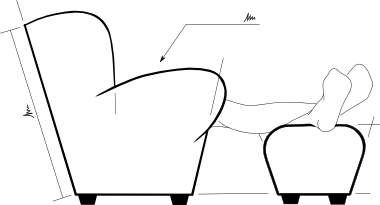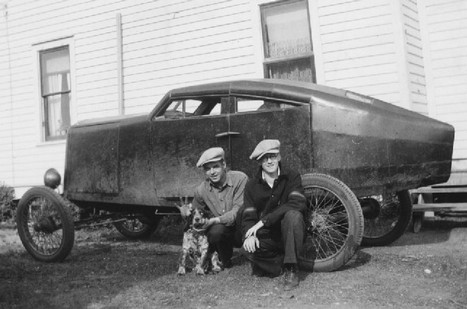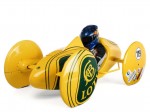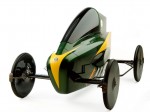Design Influences (part 1)
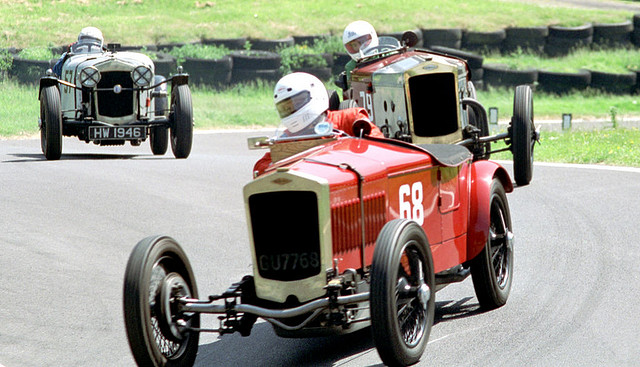 Cadwell Nashes
A group of Fraser Nashes coming up the Mountain, Cadwell Park, 2001. Creative Commons Licensed. Source, Flickr user pdcawley
Cadwell Nashes
A group of Fraser Nashes coming up the Mountain, Cadwell Park, 2001. Creative Commons Licensed. Source, Flickr user pdcawley
Frazer-Nash
As a bit of a petrolhead, I’ve liked the 20’s Fraser-Nashes for a long time, especially because or their reputation for oversteer when driven quickly. Without a differential, they will tend to understeer when driven normally (the back axles tries to keep the car straight) so to drive them quickly, getting the rear wheels to slide through corners (oversteer, or drifting) gets them to corner better. But that’s a little off topic!
As a design influence for the Atomic Duck, what I’ve taken from the Fraser-Nashes is:
-
The long, tall, thin body, especially on the single seaters. The shape is quite simple, with a tapered front, squared cabin and tapering, boat-tail. They have a small area cross-section, which is good for minimising drag.
-
The front axle line is ahead of and the wheels are set-out from the body. Putting the wheels into wheelarches in the body increases the complexity of construction. Setting the wheels away from the body gives more space for the wheels to turn, so the turning circle can be kept small, despite the elongated wheelbase.
-
The large grill at the front allows for good ventilation to the interior of a velo, for the rider. Similarly, in the Fraser-Nash, the grill allows airflow to the radiator to cool the engine.
-
Having the headlights separate from the body offers builders a better selection of lighting for builders than the integrated lights. Though external lights will increase the amount of drag slightly.
 1926/29 Frazer Nash Boulogne Vitesse 1496cc
1926/29 Frazer Nash Boulogne Vitesse 1496cc
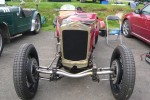 1928 Frazer Nash Super Sport
1928 Frazer Nash Super Sport
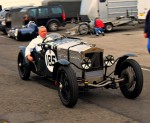 Frazer Nash Super Sports
Frazer Nash Super Sports
 Fraser Nash at Cadwell Park
Fraser Nash at Cadwell Park
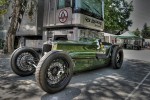 Frazer Nash Nurburg HDR
Frazer Nash Nurburg HDR
Auburn Cabin Speedster
A 1929 special racing model, the original Auburn 8-120 Cabin Speedster was destroyed in a fire at the 1929 Los Angeles Automobile Show. Designed to be “tomorrow’s automobile design, Not a fantastic dream of a groping modernist or futurist, but a practical reality based on scientific wind resistance.”[1929 Auburn Sales Brochure]
Like the Fraser-Nashes, the Auburn has a slim profile, with the front axle ahead of the radiator with separate headlights, but it also has an enclosed cabin. Covering the occupants and interior will better direct airflow of the rear of the body and should give less drag than if it was open.
[1] 1929 Auburn Cabin Speedster by Richard Spiegelman [2] 1929 Auburn Cabin Speedster by Richard Spiegelman [3] 1929 Auburn Cabin Speedster by Richard Spiegelman
Stevinson Model-T
No doubt, you’re thinking that I’m a little mad, considering vintage cars as design influences for a lighweight vehicle where aerodynamic performance is crucial. I do have an example though, to prove that there is nothing wrong with the basic shape of vintage cars.
In 1933, Harry Stevinson customised a Model-T Ford (probably a 1926/27 model), and managed to significantly reduce the fuel consumption and increase the top speed by improving the aerodynamic efficiency. Where the standard Model-T had a 20bhp engine, reached a top speed of 45mph and consumed around 30mpg (imp.); Stevinson’s improved version had 23bhp, had a 70mph top speed and fuel economy of 45mpg (imp.).
To get this kind of performance, Stevinson made two types of improvements:
-
Reduced frontal area
-
Improved airflow over the body to reduce drag
But the basic shape of the car is very similar to the Auburn Speedster.
As an idea of the efficiency of Stevinson’s car, the first Volkswagen Beetle was produced in Germany in 1944, 11 years later. It was designed to be able to cruise the autobahns at 62mph (and the top speed was not siginificatly higher) and had an engine capable of 24bhp.
[1] metrompg.com/posts/model-t-stevinson [2] jalopnik.com/cars/harry-stevinson [3] ecomodder.com/forum
Belly Tank Lakesters
After World War 2, there was a surplus of long range fuel tanks (belly tanks or drop tanks), so many that they were being sold for as little as $35 each. When the dry-lake hod-rod racers realised that the aerodynamic shape of these tanks would (just) fit a V8, drivetrain and a driver inside, Belly Tank Lakesters were born.
Don’t let the simplicity of the shape and outboard, unfaired wheels fool you, a So-Cal Special built with a P-38 Lightning tank reached 198mph in 1951, a top speed that has not been bettered by any car with the same engine.
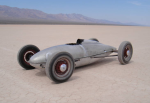 1948 Bellytank Lakester
1948 Bellytank Lakester
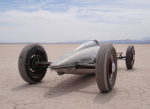 1948 Bellytank Lakester
1948 Bellytank Lakester
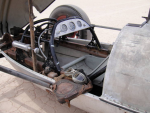 1948 Bellytank Lakester
1948 Bellytank Lakester
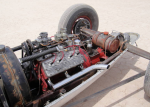 1948 Bellytank Lakester
1948 Bellytank Lakester
[1] bringatrailer.com/1948-bellytank-lakester
Lotus 119
Soapbox racers have no engine, so the top speed of the car is solely determined by its aerodynamic efficiency. The 119 series were Lotus Cars’ entries to the soapbox race at the Goodwood Festival of Speed in the early 2000s in the UK. While the race has not taken place since 2004, Lotus remain the reigning champions, and they also hold the fastsest time ever for the course with the 119c (63.810s with speeds over 63mph).
The 119 series were designed to the Goodwood regulations, so they are limited by a maximum width and length and had to have a minimum height for the driver’s eyeline; meaning it was not allowed for the driver to lie flat. Though the construction materials are different (the Lotus’ are made from carbon fibre), the 119s have a remarkably similar shape to the earlier cars above.
In particular, the 119s have:
-
A small cross-section body that is almost rectangular. The main body of the 119c has the same profile as a Fraser-Nash.
-
A “pinched” boat-tail. Except the 119a, which has a cut-off (kamm) tail.
-
The wheels set-out from the body. On the b & c, they are in cowls to reduce the drag.
-
Axles with a teardrop profile that cover the steering mechanism and brake lines
